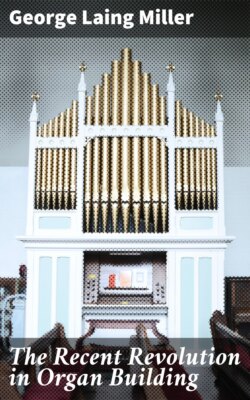Читать книгу The Recent Revolution in Organ Building - George Laing Miller - Страница 12
На сайте Литреса книга снята с продажи.
Fig. 2. The Wind-chest. Side View
ОглавлениеTable of Contents
When the apertures in the slider are under those below the pipe, the "stop," the handle of which controls the position of the slider, is said to be out, or drawn. When the apertures do not correspond, the stop is said to be in. Thus it is that when no stops are drawn no sound is produced, even although the wind-chest be full of air and the keys played upon.
This wind-chest with the slider stop control is about all that is left to us of the old form of key action. The pallets were connected to the keys by a series of levers, known as the tracker action.
There were usually six joints or sources of friction, between the key and the pallet. To overcome this resistance and close the pallet required a strong spring. Inasmuch as it would never do to put all the large pipes (because of their weight) at one end of the wind-chest, they were usually divided between the two ends and it became necessary to transfer the pull of the keys sideways, which was done by a series of rollers called the roller-board. This, of course, increased the friction and necessitated the use of a still stronger spring. That with the increased area of the pallet is why the lower notes of the organ were so hard to play. And to the resistance of the spring must also be added the resistance of the wind-pressure, which increased with every stop drawn. When the organ was a large one with many stops, and the keyboards were coupled together, it required considerable exertion to bring out the full power of the instrument; sometimes the organist had to stand on the pedals and throw the weight of his body on the keys to get a big chord. All kinds of schemes were tried to lighten the "touch," as the required pressure on the keys is called, the most successful of which was dividing the pallet into two parts which admitted a small quantity of wind to enter the groove and release the pressure before the pallet was fully opened; but even on the best of organs the performance of music played with ease upon modern instruments was absolutely impossible.
